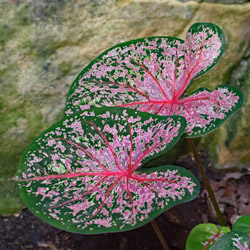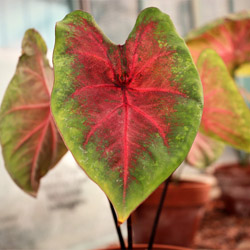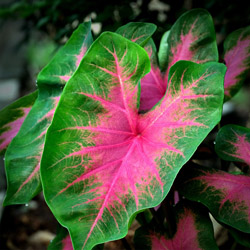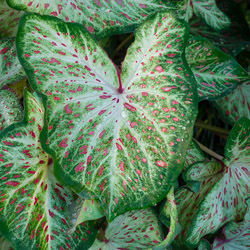Caladiums are phenomenal ornamental foliage plants, native to South America and now widely enjoyed in gardens all over the world. Gorgeous in cool, shady spaces, caladiums can make a beautiful impact in darker areas of the garden where it is a challenge to introduce color.
Discovering Caladiums
Also called angel wings or elephant ears, these plants are bold ornamentals with huge, dramatic leaves that are either lance-like, arrow, or heart-shaped. While some caladiums can grow as much as 24 inches high and wide, smaller dwarf cultivars are also available to plant in tiny gardens and containers. All caladiums possess stunningly beautiful, boldly patterned leaves in a mix of colors and hues, including green, white, pink, red, and cream. They often display flamboyant veining, spots, or flecks on the leaves making them even more breathtaking.
Caring for Caladiums
These plants grow from tubers and are easy for gardeners of all experience levels to cultivate. Caladiums are ideal in shady borders or around the trunks of trees, they can be perfect groundcovers in darker garden spots, they are an awesome filler for difficult spaces, and are even stunning in containers and pots. To prevent damage to their foliage, it is best to position caladium in a sheltered area out of strong winds. Caladium tubers can be purchased bare or already potted. Here are some tips to grow the most healthy and luscious caladiums:
- Choose large, firm tubers for the most vigorous plants with spectacular foliage. Smaller tubers will still grow, but the plant they produce will also be proportionally smaller.
- Plant caladium tubers in late spring when the soil temperature reaches 65 degrees. A soil thermometer can help ensure that the time is right for planting. You may also get a jumpstart on the season by planting caladium indoors, in pots, about 5 weeks before the anticipated last frost for your area. Simply transplant outdoors when soil temperatures are correct.
- Position caladiums in moist, well-drained garden soil that is rich in organic matter to nourish strong, healthy, vibrant plants.
- Plant the tubers in partial to full shade. These plants generally prefer cooler spots but can tolerate a little more sunlight in naturally cooler regions.
- Plant caladiums 4-6 inches apart and 4-6 inches deep. Smaller tubers may be planted closer together, while larger ones should be spaced further apart.
- Add a light layer of mulch over planted caladiums to moderate soil temperature, conserve soil moisture, and prevent weeds. Organic mulch will work best and will also continue nourishing these plants.
- Feed caladiums every 4 to 6 weeks during the growing season. Use a balanced liquid feed poured around the base of the plant or a slow-release fertilizer at time of planting. Adding compost or other amendments to the soil before planting will also assist in nourishment.
- Water caladium plants well and keep them consistently moist so that they remain beautiful, lush, and healthy during the entire growing season. A drip system or soaker hose will make watering a cinch!
Overwintering Caladiums
Caladiums are “tender” bulbs, meaning that they cannot overwinter in the ground where the soil typically freezes. When the summer ends and temperatures begin to cool, it’s time to dig up and store them for the winter. Once the foliage turns yellow and wilts, the tubers may then be carefully lifted from the ground. They should be placed in a warm, dry location for 10-14 days, during which time the foliage will continue to dry out. The leaves can then be clipped off – use clean, sharp clippers to be sure no fungus or infections are introduced – and place the tubers in a cardboard box or paper bag. Do not use a plastic bag, which will prevent air circulation necessary to keep tubers from rotting during storage and thus rendering them useless for future enjoyment. Cover stored tubers lightly with dry peat moss and store them in a cool (around 50 degrees), dry, dark location, until next spring, when they’ll be healthy and ready to plant again for more incredible foliage.
Caladiums are eye-catching in cool shade gardens. Their bold, colorful leaves and their wide selection of cultivars will add color, brightness, and uniqueness to the shady garden, landscape, front porch, and backyard entertainment space. Consider adding a little drama to your yard this summer.












